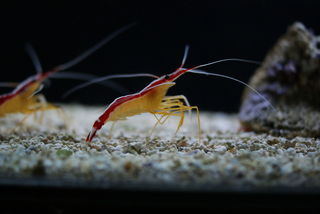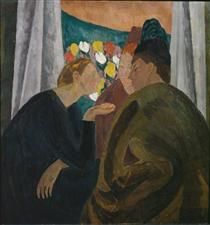Jealousy
Do Cleaner Shrimp Get Jealous?
Another way of thinking about jealous triangles.
Posted February 17, 2017

The Lysmata amboinensis is hermaphrodite, but with a limitation. This version of the cleaner shrimp can’t self-fertilize. It needs a mate. Janine Wong from the University of Basel explained to the New Scientist (November 17, 2011) that competition for food makes the Lysmata amboinensis so aggressive that they will kill off other competing shrimp - but they won’t kill off their mate. Dr Wong put sets of three or four shrimp together in tanks (reported in “Control of social monogamy through aggression in a hermaphroditic shrimp”, DOI: 10.1186/1742-9994-8-30). “During the day they barely interacted, but [at night],” she explains, “they started to go crazy and chase one individual until they had killed it." The carnage continued until the two paired up shrimp were left. By day they ate their victims. “The shrimp fought to the death even when they had access to plenty of food,” explains the New Scientist, “suggesting that it had nothing to do with resources and everything to do with living in pairs.”
Are these ferocious little shrimp feeling a little jealous? When they eat the competitors in their tanks are they acting out some primitive version of crustacean jealousy? It sounds like it, that’s if their violence is linked to their need to live in pairs. Or could it be that their actions are merely the unfolding of the cruel, but Darwinian constraints of hungry animal survival? Is it silly to pose such a question concerning shrimps and jealousy? How could a shrimp possibly experience the complex and painful emotion that humans do? Shrimps don’t have human brains.
But if we’re using a definition of jealousy that’s based on what you can see rather than one that’s based on how a creature may feel, then calling these fierce little shrimps jealous is maybe not so silly at all. Jealousy? It can be seen in competitive triangular situations. One individual may be forced to or think they’re being forced to give up someone, or something, to another creature. In these situations feelings run high and you can see this in the agitation of the participants. If you stick to this phenotypical diagnosis, then it doesn’t matter whether the situation involves animals or humans. Their feelings are not necessarily important. It is what they are seen to do that’s important.
The cleaner shrimp have always puzzled me. I’d assumed that something like jealousy was what motivated them. I imagined that there was a jealous triangle here. I reckoned that the triangle must be made up of the two shrimp acting in jealous concert against the soon-to-be-gobbled-up shrimp, the third element of the trio. I don’t believe, now, that it’s as simple as that at all. There’s still jealousy, I believe, but a different triangle. It's better to say that the triangle is this: the two hooked up shrimps act in concert (acting as one, and acting as the first element of the triangle), against the other unpaired shrimps (the second element of the triangle), for control of the tank and its resources (the third element). What’s unusual in this configuration is that, normally, in the jealous triangles I’ve known or read about, each of the players appears to act more or less independently.
But that’s not always the case. Here’s a human example that’s a bit like the cleaner shrimps and their mortal combat. It comes from the life of the Swedish film director, Ingmar Bergman. In his autobiography, The Magic Lantern (1987), there’s a vivid example of the four-year-old Ingmar and his older brother, Dag, acting just like a violent and steamed up pair of Lysmatae amboinenses. They’re after their new young sister, Margareta.
"When I was four, my sister was born … A fat monstrous creature had suddenly acquired the main role. I was banished from my mother’s bed and my father beamed over this bawling bundle. The demon of jealousy fastened its claws into my heart. I raged, wept, crapped on the floor, and messed myself. My brother and I, usually mortal enemies, made peace and planned various ways of killing this repulsive wretch. For some reason, my brother considered I should do the deed. I was flattered and we looked for a suitable moment."
Little Ingmar Bergman climbed onto a chair and attempted to strangle his baby sister in her cot. But he slipped and fell to the floor, his sister survived, and cinema was changed forever. Margareta lived on to become a distinguished novelist. She’s also the real-life Fanny in Fanny and Alexander, if you’ve ever seen that excellent movie
This Swedish triangle is made up of Ingmar and his brother, Dag, who comprise the first element, then his little sister Margareta as the second element of the triangle, and his parents, Erik and Karin, the third element. The boys wanted to do away with their baby sister. That way they’d again be the main beneficiaries of their parents’ affections. They want to preserve their standing. In an arrangement like this one Erik and Karin, you could say, represent the cleaner shrimps’ tank. You get the fishy picture.
There are plenty of parallels for this sort of behavior, when you come to think of it. These can be in human life – in the family, as we’ve just seen, but also in the playground, in the workplace, in social life, or even in such offbeat places as mythology. You also seem to witness it in criminal associations. I wonder if it’s the case that that jealous triangles of the cleaner-shrimp sort and of the Ingmar Bergman variety, triangles that are made up of two or more people acting together against another person for control of some particular space or item or individual, are the more violent and harmful of jealous configurations? I think they are. But I can’t prove it. I can only suggest it. Here are some examples, two of them historical, to bulk out my guess.
Procne and Philomela were two infamous sisters from Greek mythology. I’ve spoken of them before. Procne and Philomela were two savage cleaner shrimps, if ever there were. What were they up to? Tereus, the King of Thrace, had married Procne. When her sister Philomela came to visit Procne, Tereus abducted her before she could get to the court and to her sister. He raped Philomela. He cut out her tongue to stop her from betraying him to his wife and hid Philomela away in a cabin in the woods. But the truth eventually was out and Procne, in equal measure, jealous of the betrayal by her husband but horrified for her sister, took revenge with her sister on Tereus. They killed Procne’s little son by Tereus, Itys. They cooked him and served him as a meal to the rapist husband. They made Tereus a cannibal of his own child in revenge for the rape and mutilation and contempt for his family.
How does the jealousy work in this story? Procne and Philomela work together, as the first element of the jealous triangle and destroy young Itys (the second element). Procne and Philomela’s aim is reassert control over their family and Tereus (the third element in the triangle). Their jealousy is exerted in a bizarre manner – by destroying the king’s family. Procne and Philomela kill the child to take back control of the marriage (the fish tank as it were) that has been destroyed violent and unfaithful Tereus. They act just like the cleaner shrimp.
And so did the southeast Senegal gang of chimps at Fongoli who killed their former alpha male, known as Foudouko, reports Jill Pruetz in the International Journal of Primatology (doi.org/bxx2). The gang beat Foudouko up, then ate him. It seems to have been all about the control of their society and mating space. Foudouko had been the tyrannical alpha of the group, but over 5 years ago he was ousted from his position and moved into retirement. Recently he tried to make a comeback. The younger chimps wouldn't have a bar of it and killed him. It was the older females who cannibalized him. It’s easy to see how the triangle works here: the gang (not a mere pair of cleaner shrimp), ageing Foudouko, and, as the third element, control of the group or, you might say, society (the fish tank).
Here is one last example. This one is not at all horrifying. It is an elegant and apparently harmless version of our triangle. It dramatizes jealousy in social life. There’s none of the violence of the shrimps’ fish tank here, but there is an undertone of menace. It’s a painting by the English artist, Vanessa Bell (1879-1961 – she was the sister of Virginia Woolf), and it’s called The Conversation (1916).

I’m going to say that the triangle here is made up, first, of the two hostile women on the right. Their victim and the second element (the solitary shrimp) is the hunching woman on the right. The fish tank is their social world. Look at her eyes. The two women on the right, acting in concert, assert their dominance over the woman on the left.
Find this hard to swallow? Look more closely. The woman on the left is losing the exchange with the two on the right. Bareheaded, bare necked, vulnerable necked, no coat, no hat, her right hand seems to be requesting something. Is it a favor? A handout? Is this why she is pink cheeked? Embarrassment? The way that her head stretches forward at a lower level to the two women on the right makes her seem to be asking for something. Their slit-eyed, stiff necked, tight-lipped response is negative. They won’t even take their hands out from within their plutocratic coats. Closed in and closed together they wish nothing well to the woman in black.
What is the dispute over? What is the third element? We can only guess. But it feels to me that it has something to do with social standing. That’s the fish tank, their social milieu. The woman on the left wants in, wants to be accepted. The two women on the right won’t have it. The social fish tank is all theirs. There’s no physical violence in this scene, but there seems to be plenty of psychological violence. And you don’t have to be told or even to guess what the feelings are here. You can see them. It’s another fishy picture.
Jealousy entails a triangular situation in which one or more of the players, animal or human, are liable to loss. The permutations within the triangle are more varied than you might expect. It can be one against one – you against the interloper. But it can also be two against one (Ingmar Bergman as well as Procne and Philomela), a couple against an interloper (the cleaner shrimps), or even two against two (the shrimps again), or a group against a single individual (poor old Foudouko). It feels like that is what we see some of this even in a work of art like The Conversation. They all offer another and unexpected way of looking at the jealous triangle.
February 17, 2017




